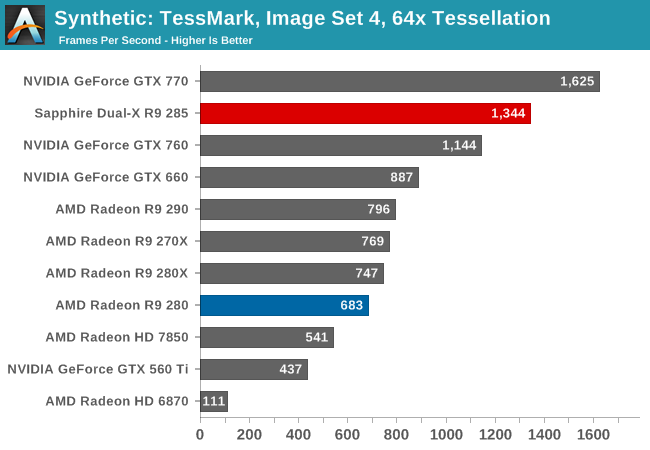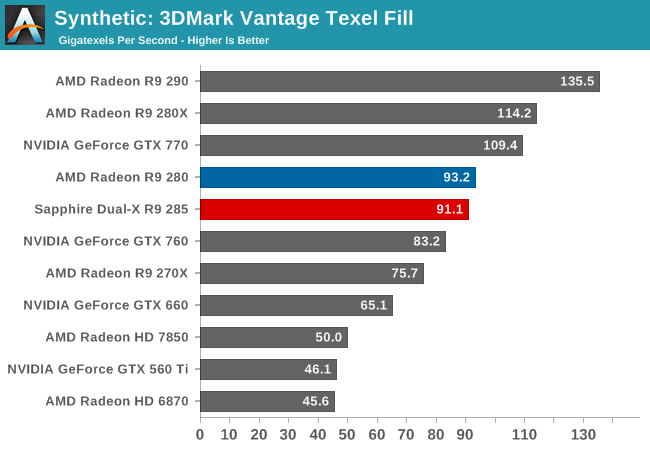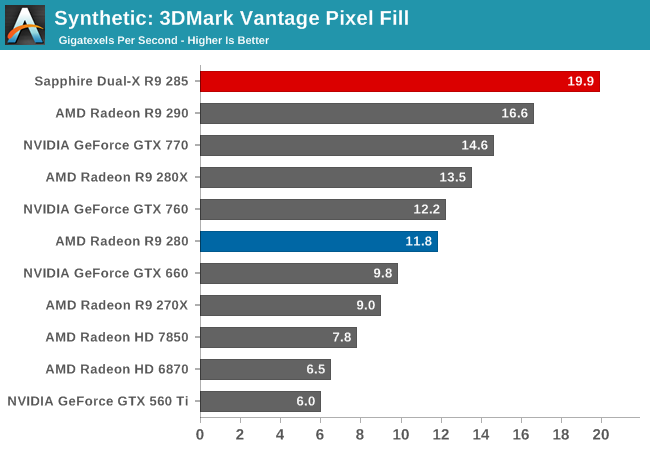AMD Radeon R9 285 Review: Feat. Sapphire R9 285 Dual-X OC
by Ryan Smith on September 10, 2014 2:00 PM ESTSynthetics
As always we’ll also take a quick look at synthetic performance. As we briefly discussed in our look at the GCN 1.2 architecture these tests mainly serve as a canary for finding important architectural changes, and one of these tests in particular has been significantly impacted by AMD’s newest round of architectural improvements.

At the x64 tessellation factor we see the R9 285 spit out 134fps, or equivalent to roughly 1.47B polygons/second. This is as compared to 79fps (869M Polys/sec) for the R9 290, and 68fps (748M Polys/sec) for the R9 280. One of the things we noted when initially reviewing the R9 290 series was that AMD’s tessellation performance didn’t pick up much in our standard tessellation benchmark (Tessmark at x64) despite the doubling of geometry processors, and it looks like AMD has finally resolved that with GCN 1.2’s efficiency improvements. As this is a test with a ton of small triangles, it looks like we’ve hit a great case for the vertex reuse optimizations.
Moving on, we have our 3DMark Vantage texture and pixel fillrate tests, which present our cards with massive amounts of texturing and color blending work. These aren’t results we suggest comparing across different vendors, but they’re good for tracking improvements and changes within a single product family.

With AMD maintaining their same texture units and same tex:FP32 ratio for Tonga, the end result is that R9 285’s texturing performance is virtually identical to R9 280’s. Ignoring any possibility of caching or bandwidth bottlenecking for the moment, R9 285 can push texels just as well as R9 280 could.

Unlike our texel test, AMD’s delta color compression technology introduced on GCN 1.2 has an incredible impact on R9 285’s pixel throughput. This pixel test is normally memory bandwidth bound, providing something that approaches a best case scenario for AMD’s compression technology. As a result despite possessing nearly 30% less memory bandwidth than the R9 280, the R9 285 tops our charts at 19.9 GPix/sec, blowing past the R9 280 by 68%. Even the R9 290 with its 512-bit memory bus and doubled ROP count still falls short here by over 3GPix/sec, or 16%.
This benchmark in a nutshell is why AMD can deliver the average performance of the Tahiti based R9 280 without Tahiti’s memory bandwidth. By improving their color compression to this point AMD can significantly reduce their memory bandwidth requirements on GCN 1.2, allowing them to do more with less. In real games the result won’t be anywhere near this remarkable since this is a pure pixel fillrate test, but it goes to show that AMD has been able to neutralize their memory bandwidth deficit in graphics workloads.










86 Comments
View All Comments
felaki - Wednesday, September 10, 2014 - link
The article says that the Sapphire card has "1x DL-DVI-I, 1x DL-DVI-D, 1x HDMI, and 1x DisplayPort". Can you be more precise as to which versions of the spec are supported? Is it HDMI 1.4 or HDMI 2.0? I believe since this refers to MST, it's only HDMI 1.4 and a DisplayPort connection is required in MST mode for 4K@60Hz output?Reading the recent GPU articles, I'm very puzzled why HDMI 2.0 adoption is still lacking in GPUs and displays, even though the spec has been out there for about a year now. Is the PC industry reluctant to adopt HDMI 2.0 for some (political(?), business(?)) reason? I have heard only bad things about DisplayPort 1.2 MST to carry a 4K@60Hz signal, and I'm thinking it's a buggy hack for a transitional tech period.
If the AMD newest next-gen graphics card only supports HDMI 1.4, that is mind-boggling. Please tell me I'm confused and this is a HDMI 2.0-capable release?
Ryan Smith - Wednesday, September 10, 2014 - link
DisplayPort 1.2 and HDMI 1.4. Tonga does not add new I/O options.felaki - Wednesday, September 10, 2014 - link
Thanks for clarifying this!Penti - Wednesday, September 10, 2014 - link
You can do 4K SST on both Nvidia and AMD-cards as long as they are DisplayPort 1.2 capable. It depends on your screen. There is no HDMI 600MHz on any graphics processor. Neither is their much of support from monitors or TVs as most don't do 600MHz.felaki - Wednesday, September 10, 2014 - link
Thanks! I was not actually aware that SST existed. I see here http://community.amd.com/community/amd-blogs/amd-g... that AMD is referring to SST as being the thing to fix up the 4K issue, although the people in the comments on that link refer that the setup is not working properly.How do people generally see SST? Should one defer buying a new system now until proper HDMI 2.0 support comes along, or is SST+DisplayPort 1.2 already a glitch-free user experience for 4K@60Hz?
Kjella - Wednesday, September 10, 2014 - link
Got 3840x2160x60Hz using SST/DP and it's been fine, except UHD gaming is trying to kill my graphics card.mczak - Wednesday, September 10, 2014 - link
DP SST 4k/60Hz should be every bit as glitch free as proper hdmi 2.0 (be careful though with the latter since some 4k TVs claiming to accept 60Hz 4k resolutions over hdmi will only do so with ycbcr 4:2:0). DP SST has the advantage that actually even "old" gear on the graphic card side can do it (such as radeons from the HD 6xxx series - from the hw side, if it could do DP MST 4k/60Hz it should most likely be able to do the same with SST too, the reason why MST hack was needed in the first place is entirely on the display side).But if you're planning to attach your 4k TV to your graphic card a DP port might not be of much use since very few TVs have that.
Solid State Brain - Wednesday, September 10, 2014 - link
I won't get another AMD video card until idle multimonitor consumption gets fixed. According to other websites, power consumption in such case increases substantially whereas NVidia video cards have almost the same consumption as when using a single display. In the case of the Sapphire 285 Dual-X it increases by almost 30W just by having a second display connected!!I think Anandtech should start measuring idle power consumption when more than one display is connected to the video card / multimonitor configurations. It's an important information for many users who not only game but also need to have productivity needs.
Solid State Brain - Wednesday, September 10, 2014 - link
And of course, a comment editing function would be useful too.shing3232 - Wednesday, September 10, 2014 - link
well, AMD video card have to run higher frequency with multiscreen than with a single monitor